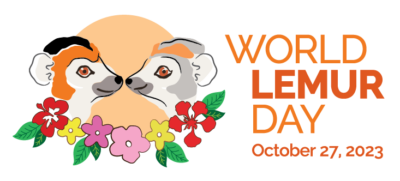What animal loves to bask in the sun, has sweat glands in their wrists, and is found only in Madagascar? The lemur! Let’s learn some fun facts about lemurs: what makes lemurs unique, how many species there are, and how you can help them.
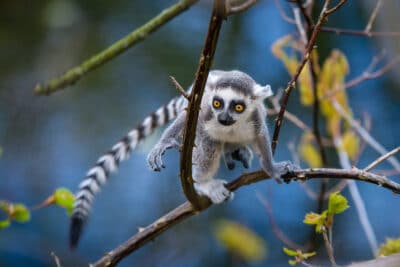
Ring-tailed lemur baby. Photo: Mathias Appel.
1. Madagascar is the only place lemurs naturally call home.
Located 250 miles off the east coast of Africa is the island of Madagascar, the 4th largest island in the world, and the only habitat for wild lemurs in the world.
Madagascar is one of the world’s most important biodiversity hotspots! While a large proportion of its wildlife found nowhere else, much of Madagascar’s wildlife is also threatened by human actions.
Interestingly, some lemur species—the brown lemur and mongoose lemur—were introduced by humans and now live on the Comoros islands, a volcanic group of islands located off the north west coast of Madagascar (1).
2. There are over 100 species of lemur, in all shapes and sizes.
With an estimated 112 species, lemurs come in all shapes and sizes. The smallest, Madame berthe’s mouse lemur, has an average body weight of 30g, and the largest, the indri, weighs about 6-9.5kg (that’s about the size of a human child!). The number of lemur species changes often due to new discoveries and genetic testing, leading to the scientific classification of new species!
The indri is the largest of the living lemurs, however subfossil records show extinct lemurs as large as 85kg! Most notably, Archaeoindris fontoynontii is an extinct giant lemur that belonged to the “sloth lemur” family. It was thought to be the size of a gorilla! (2).
Fact Sheet for the Indri3. Lemurs have a female-dominant society.
Who rules the world? Well, in lemur society the females rule! At the center of lemur society is a female leader who rises to the occasion of directing a social group. This happens quite rarely in mammals, where male dominance generally stands. Lemur females show signs of dominance in the way they mark their territories within the group. Another fact is that female lemurs snatch food away from the males, kick them out of sleeping spots, and show actual physical aggression (3, 4, 5).
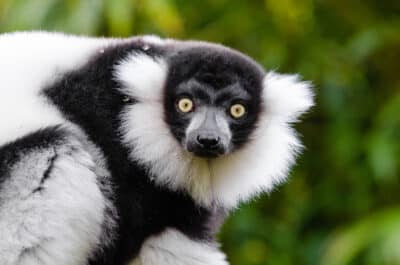
Black and white ruffed lemurs are pollinators. Photo: Mathias Appel.
4. As crucial seed dispersers, lemurs are “creators of the forests”.
Lemurs help maintain forest diversity, structure, and dynamics through the movement of seeds! Yes, some lemur species play a significant role in their ecosystem by being seed dispersers. But what does this mean?
Being a seed disperser means they help seeds and/or pollen move from one area to another. Ruffed lemurs, like the black and white ruffed lemur, is a good example of a lemur that acts as a key seed disperser.
Individual lemurs can get pollen or seeds stuck on their fur as they search for fruits and nectar. Then, they pass this pollen and seeds on to other flowers. Sometimes seeds even get dispersed to new areas when lemurs eat fruit; the seeds pass through their digestive system and are excreted in their poop!
Many of Madagascar’s flowering plants and tree species depend highly on lemur species, such as the ruffed lemurs, to disperse their seeds (6).
Fact Sheet for the Black and White Ruffed Lemur5. Besides humans, lemurs are one of the only primates that have blue eyes.
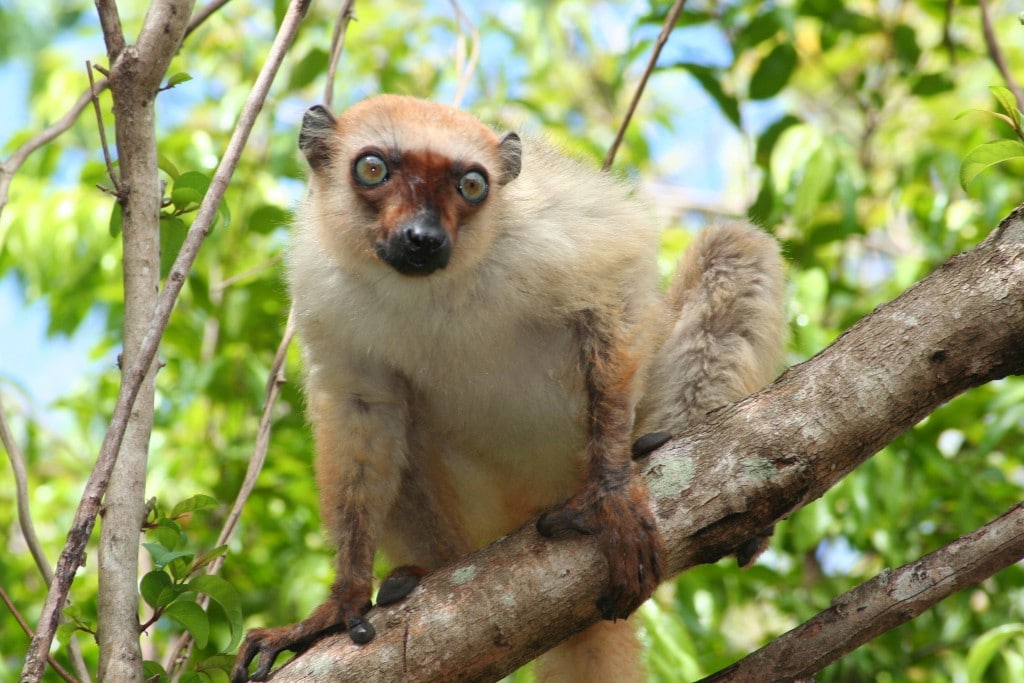
Female blue-eyed black lemur. Photo: Melanie Seiler.
Primates have a variety of eye shapes and colors, but blue irises are rare in mammals. Other than humans, the only primates with naturally occurring blue eyes are the blue-eyed black lemurs, sometimes called Sclater’s lemurs. The blue-eyed black lemur is one of the most threatened lemur species, listed as Critically Endangered on the IUCN Red List of threatened species (6).
Lemur Conservation Network member AEECL supports conservation efforts for the blue-eyed black lemur both in their natural habitat and in zoos!
6. Lemurs self-medicate, and some get high off of millipedes.
Who needs a pharmacy when you live in the forest?! Some lemur species use the forest to self medicate, acting as their own personal pharmacy. Red-fronted brown lemurs eat millipedes to get rid of gastrointestinal parasites, such as worms. It is thought that the toxins within the millipedes kill the parasites that set up home in the lemurs’ guts (7).
7. Some lemurs sing a capella. Others communicate with stink!
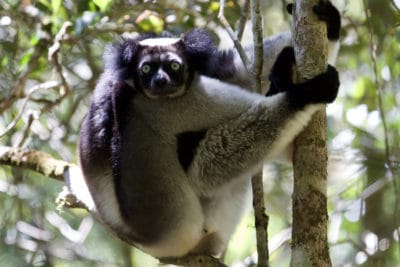
An indri sitting in a tree in Madagascar. Photo: Travis Steffens.
In the rainforests of east Madagascar you will often hear the songs of the indri. Indri are the talented a capella group of the animal kingdom, with both the males and females singing, and often in sync with each other. The reason that indris sing can vary based on location and the animal hearing it. One reason is to mark its territory and let others know ‘Hey, this is my space. Find your own!’ (8).
Ring-tailed lemurs also communicate and mark their territory in a unique way. They have scent glands on their wrists and chest, which are particularly useful during the breeding season. A male will mix secretions from his wrist and chest glands to mark his territory, and lift his tail to prepare for a ‘stink fight’ against a rival. The dispute ends only when one gives up as they waft the strong smells into each other’s faces with their tails! (9)
Fact Sheet for the Ring-tailed Lemur8. Lemurs are the world’s oldest living primates.
A fact that few people know is that lemurs are considered the world’s oldest primates! The story of lemurs begins over 70 million years ago, long before humans. This was a world when lemur-like animals, the planet’s first primates, roamed Africa along with the dinosaurs. Scientists think that around 65 million years ago, lemurs rafted across the Indian Ocean to the island of Madagascar on floating vegetation. Over the next tens of millions of years, the lemurs evolved and diversified on Madagascar to the 112 species that we see today.
 9. Lemurs are celebrated around the world at the end of October for the World Lemur Festival!
9. Lemurs are celebrated around the world at the end of October for the World Lemur Festival!
World Lemur Day is the last Friday of October every year, and the World Lemur Festival is celebrated the week before! Use this day to learn all about lemurs and Madagascar, share about lemurs with your friends and family, and learn how you can help save them from extinction!

Adrien, one of the founders of Anja Reserve, is a guide for the southwestern region of Madagascar. Photo: Lynne Venart.
10. Protecting lemurs benefits the Malagasy people.
The protection of lemurs also benefits the Malagasy people. For one, as seed dispersers, lemurs help forests grow, and many local people depend on forests for resources.
And, tourists visiting Madagascar to see lemurs in the wild boosts the local economy. Because Madagascar is one of the world’s financially poorest countries, it is especially important to support Malagasy people. By improving the country’s local and national economies, ecotourism can help Malagasy people thrive in coexistence with nature. Madagascar’s government has prioritized tourism by increasing funding to promote the island as an ecotourism destination.
Importance of Ecotourism in MadagascarWant to learn more about lemurs?
About the Authors
This post was co-authored by Coral Chell and Rachel Hudson. Coral has a BSc (Honors) in Zoo Biology and an MSc in Endangered Species Recovery and Conservation. Rachel (Rae-Rae) is a freelance writer, entrepreneur and big fan of animals.
Sources
- Mittermeier et al. (2010). Lemurs of Madagascar. 3rd Edition. Conservation International.
- Kappeler, P.M. (1990). Female dominance in Lemur catta: more than just female feeding priority?. Folia Primatologica, 55(2), pp.92-95.
- http://pin.primate.wisc.edu/factsheets/entry/ring-tailed_lemur/behav#:~:text=The%20hierarchy%20among%20ring%2Dtailed,the%20rank%20of%20their%20mothers.&text=Males%20have%20a%20separate%20dominance,Jolly%201966%3B%20Sussman%201992).
- http://www.bbc.com/earth/story/20150514-extraordinary-pollinators
- Volampeno, S., Randriatahina, G., Schwitzer, C. & Seiler, M. (2020). Eulemur flavifrons. The IUCN Red List of Threatened Species 2020: e.T8211A115563094. https://dx.doi.org/10.2305/IUCN.UK.2020-2.RLTS.T8211A115563094.en
- Peckre, L.R., Defolie, C., Kappeler, P.M. and Fichtel, C., (2018). Potential self-medication using millipede secretions in red-fronted lemurs: combining anointment and ingestion for a joint action against gastrointestinal parasites?. Primates, 59(5), pp.483-494.
- Pollock, J.I. (1986) The song of the Indris (Indri indri; Primates: Lemuroidea): Natural history, form, and function. International Journal of Primatology. 7, 225–264
- https://lemur.duke.edu/ring-tailed-lemur-scent-marking-and-breeding-season/.
- Stankiewicz, J., Thiart, C., Masters, J.C. and De Wit, M.J., (2006). Did lemurs have sweepstake tickets? An exploration of Simpson’s model for the colonization of Madagascar by mammals. Journal of Biogeography, 33(2), pp.221-235.

